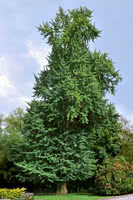Mon-Fri 9am - 5pm Mountain time
Ginkgo Biloba vs Mountain Maple
Ginkgo biloba
Acer spicatum
NOT AVAILABLE THIS SEASON - MIGHT RETURN
CUSTOM GROW
The Ginkgo Biloba is regarded as one of the most distinctive and beautiful of all the deciduous trees, and has remained genetically unchanged for millions of years. Its beautifully fan-shaped leaves develop a clear yellow colour in fall. Graceful and attractive year-round, Ginkgo is the perfect conversation starter in your yard.
Used to growing in the shadows of the damp forest, White Maple (aka Mountain Maple) is a great fit for shady and wet areas, such as beneath larger trees. Unlike most of its cousins, the White Maple is a shrub instead of a tree. It's still a maple, however, with sap that can be made into Maple syrup to prove it!
In May and June, the classic shapes of Maple leaves are joined by clusters of green and yellow flowers. Soon after, red samaras (aka helicopter seeds or whirligigs) appear. This distinctive appearance makes White Maple an excellent choice for giving urban yards a unique (and patriotic) look.
Ginkgo Biloba Quick Facts
Mountain Maple Quick Facts
Toxicity: Uncooked nuts in large quantities

